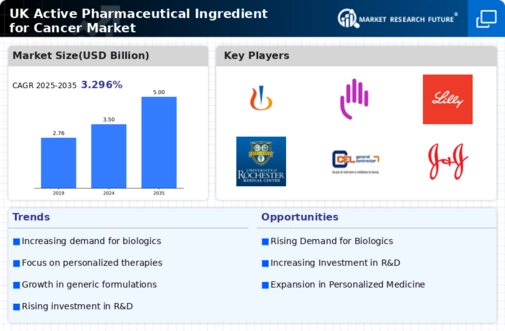Rising Incidence of Cancer
The increasing prevalence of cancer globally drives the Global UK Active Pharmaceutical Ingredient for Cancer Market Industry. As cancer cases continue to rise, the demand for effective treatment options escalates. In 2024, the market is projected to reach 12.5 USD Billion, reflecting a growing need for innovative therapies. This trend is likely to persist, with estimates suggesting that by 2035, the market could expand to 25 USD Billion. Such growth indicates a compound annual growth rate of 6.5% from 2025 to 2035, highlighting the urgency for pharmaceutical companies to develop and supply active pharmaceutical ingredients that cater to diverse cancer types.
Advancements in Biotechnology
Technological advancements in biotechnology significantly influence the Global UK Active Pharmaceutical Ingredient for Cancer Market Industry. Innovations in drug development, including targeted therapies and personalized medicine, enhance treatment efficacy and patient outcomes. These advancements facilitate the creation of novel active pharmaceutical ingredients, which are essential for developing new cancer treatments. As the industry evolves, the integration of biotechnology is expected to drive market growth, with the potential for new therapies to emerge. The focus on precision medicine aligns with the increasing demand for tailored cancer treatments, further propelling the market's expansion in the coming years.
Growing Demand for Generic Drugs
The rising demand for generic drugs significantly impacts the Global UK Active Pharmaceutical Ingredient for Cancer Market Industry. As healthcare costs continue to rise, patients and healthcare providers increasingly seek affordable treatment options. Generic drugs, which are often more cost-effective than their branded counterparts, contribute to market growth by providing accessible cancer therapies. This trend is expected to persist as healthcare systems prioritize cost containment. Consequently, the production of active pharmaceutical ingredients for generics is likely to increase, further driving the market's expansion and ensuring that a wider range of patients can access essential cancer treatments.
Government Initiatives and Funding
Government initiatives and funding play a crucial role in shaping the Global UK Active Pharmaceutical Ingredient for Cancer Market Industry. Various health authorities are investing in cancer research and development, which fosters innovation in active pharmaceutical ingredients. These initiatives often include grants, subsidies, and public-private partnerships aimed at accelerating drug development processes. Such support not only enhances the availability of new treatments but also encourages collaboration among stakeholders in the pharmaceutical sector. As a result, the market is likely to benefit from increased investment, leading to the introduction of more effective cancer therapies in the near future.
Emerging Markets and Global Expansion
Emerging markets present substantial opportunities for the Global UK Active Pharmaceutical Ingredient for Cancer Market Industry. As countries develop their healthcare infrastructures, the demand for cancer treatments is expected to rise. Pharmaceutical companies are increasingly focusing on global expansion strategies to tap into these markets, which may lead to increased production and distribution of active pharmaceutical ingredients. The growth potential in regions such as Asia-Pacific and Latin America could significantly contribute to the overall market size. As these markets mature, they may become key players in the global landscape, influencing trends and driving innovation in cancer therapies.
























Leave a Comment